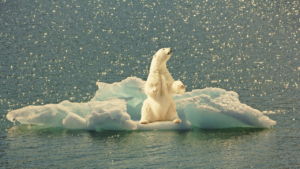Physical Address
23,24,25 & 26, 2nd Floor, Software Technology Park India, Opp: Garware Stadium,MIDC, Chikalthana, Aurangabad, Maharashtra – 431001 India
Physical Address
23,24,25 & 26, 2nd Floor, Software Technology Park India, Opp: Garware Stadium,MIDC, Chikalthana, Aurangabad, Maharashtra – 431001 India

CLAIM
Climate Change has no role in the extinction of animals. Creation and destruction are natural ways of the world.
FACT
Though there are factors like pollution and overfishing at play, the single biggest player contributing to the extinction of animals, as of now, is climate change. With thousands of species categorized as vulnerable, and thousands more as endangered, and critically endangered, it can be concluded that this isn’t natural and the steps being taken to make things right must be speeded up at all costs.
SOURCE OF THE CLAIM
We found a video on Facebook which had this claim, among a few others.
WHAT THEY SAY
Nature has always been evolving. Some animals have lived on the planet for certain periods and died out due to natural causes. This has been going on historically and will continue to happen. Climate change is not a contributing factor in the extinction of animals.
WHAT WE FOUND
The Bramble Cay Melomys, a little brown rat found only on a small sand island near the coast of Papua New Guinea (PNG), has not been seen since 2009.

A Bramble Cay Melomys, Source: Wikipedia
An article on the official website of the International Union for Conservation of Nature (IUCN) states that this rodent is “the first mammal reported to have gone extinct as a direct result of climate change. Previously found only on the island of Bramble Cay in Great Barrier Reef, its habitat was destroyed by rising sea levels.” IUCN is the global authority on the status of the natural world and the measures needed to safeguard it.
A BBC news report on the Bramble Cay Melomys, published on February 20, 2019, quoted a Queensland State Report from 2016 which said: “Significantly, this probably represents the first recorded mammalian extinction due to anthropogenic climate change.” The Australian Government’s decision to list the species as extinct came in 2019.
Yet, there is a section of society that believes that climate change cannot be a cause for the extinction of animals. They believe creation and destruction are natural ways of the world.
RATE OF EXTINCTION
Science, however, has evidence to prove that this process of “creation and destruction” of species is speeding up due to the impact of climate change. The UN’s Intergovernmental Panel on Climate Change said in February 2022 that nearly one in 10 of all species are staring extinction in the face due to the change.
An article published on the UN Sustainable Development Goals website, about the IPBES Global Assessment Report on Biodiversity and Ecosystem Services, published in May 2019 states that an ‘Unprecedented’ dangerous decline in nature is leading to an acceleration in extinction rates in species. The report found that around 1 million animal and plant species are now threatened with extinction, many within decades, more than ever before in human history. “The average abundance of native species in most major land-based habitats has fallen by at least 20%, mostly since 1900,” it says, adding that 75% of the terrestrial environment has been “severely altered” to date by human actions. The marine environment has been altered by 66%. The data has raised fears that the world is entering the sixth era of mass extinction.
The report states that the five direct drivers of change in nature with the largest relative global impacts so far, in descending order are: (1) changes in land and sea use; (2) direct exploitation of organisms; (3) climate change; (4) pollution and (5) invasive alien species. The Assessment also found that Greenhouse Gas emissions have doubled since 1980, “raising average global temperatures by at least 0.7 degrees Celsius – with climate change already impacting nature from the level of ecosystems to that of genetics – impacts expected to increase over the coming decades, in some cases surpassing the impact of land and sea use change and other drivers.”
A STUDY ON RISING TEMPERATURES AND EXTINCTION
A study– “Recent responses to climate change reveal the drivers of species extinction and survival,” by authors Cristian Román-Palacios and John J. Wiens, published in February 2020, on PNAS states that the increase in maximum annual temperatures was the most important variable associated with local extinctions and that maximum temperatures increased roughly three times more at sites with local extinction than those without. The findings have been summarised as “our study identifies the specific climatic factors that are associated with the widespread local extinctions that have already occurred due to anthropogenic climate change. We find that the absolute increases in hottest temperatures during the year are most strongly associated with local extinction, more so than changes in precipitation or in other temperature-related variables.”
RISE IN TEMPERATURE
NASA states that the Earth’s surface continues to be significantly warm, with recent global temperatures being the hottest in the past 2,000-plus years. The graph below, taken from NASA’s website, tracks changes in global mean temperature since the year 1880. The website states that “Nineteen of the hottest years have occurred since 2000, with the exception of 1998, which was helped by a very strong El Niño. The year 2020 tied with 2016 for the hottest year on record since record-keeping began in 1880.”

NASA Graph showing the change in Global Surface Temperature relative to 1951-1980 Average Temperatures.
IMPACT ON THE ECOSYSTEM
The fact that all species live at some stage and eventually die out, as we’ve seen in history, does make it feel like extinction is a natural process. But this process has been speeded up and is by no means what can be called an Evolutionary Rate. The extinction of any species of flora or fauna causes a gaping hole in the Ecosystem and affects the Environment.
Category: